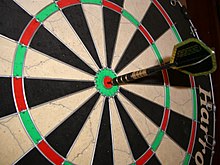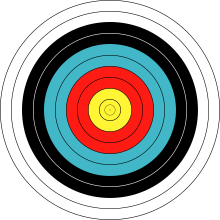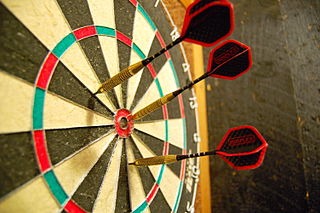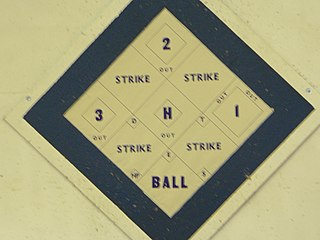

The bullseye or bull's eye has, since 1833, [1] been the name for the center of a target and, by extension, since 1857, [1] has been given to any throw, toss, or shot that hits the center.


The bullseye or bull's eye has, since 1833, [1] been the name for the center of a target and, by extension, since 1857, [1] has been given to any throw, toss, or shot that hits the center.
The term "bullseye" had been used since the Middle Ages to describe a hole, in particular where the breadth and thickness of the object was much larger than the hole. [2] In this sense, it was commonly used to describe the pontil mark on medieval crown-glass windows, where a blob (bullion, from the French boule) of molten glass was attached to a pole and spun rapidly to flatten it out into a large disk, from which windows were cut. The center was much thicker, with a small divot where the pole was attached, and this was referred to as the bullseye. The bullseye was too dense for making windows but often used for making crown-glass lenses or deck prisms in ships to let in light to the hold below deck, and these were also called bullseyes. By extension, police lanterns with lenses for focusing light into a spot became known as bullseyes. This thick glass was also called the crown, and the term bullseye became a slang term to refer to the British crown coin. Its use to describe the center of a target was first recorded in 1833, according to the Oxford English Dictionary, or possibly as early as 1813, according to other sources. [3] [4]
In some archery traditions, the term "gold" is used in preference to "bullseye". In target archery, hitting the center ring of an international target is worth 10 points, or 9 points if it's an Imperial target.[ citation needed ]
In Japanese archery, known as Kyūdō, the bullseye is called "zuboshi". [5] The term is also used as idiomatic slang just as it is in English, to note that someone has done or said something that hits "right on the nose."
In darts, the bullseye is located 5 foot 8 inches (1.73m) above the floor. [6] Before the start of a match, players will usually throw closest to the bullseye to decide who has the advantage of throwing first. An inner bullseye (sometimes called a "double bullseye" in amateur play) is a smaller inner circle and counts for 50 points, while an outer bull is worth 25 points. [7] In the World Grand Prix, which has a double start format, an inner bullseye can begin a leg. In the dart golf game, the bullseye is part of a three-part tiebreaker that includes the treble twenty.
Hitting three bullseyes in darts is known as the "Alan Evans shot". [8]

Darts or dart-throwing is a competitive sport in which two or more players bare-handedly throw small sharp-pointed projectiles known as darts at a round target known as a dartboard.
Bullseye is a British darts-themed television game show created by Andrew Wood and Norman Vaughan. The show features three pairs of contestants, each consisting of an amateur darts player and a quizzer, competing in darts games and quizzes to win cash and prizes.

The oche, also the throw line or toe line, in the game of darts is the line behind which the throwing player must stand. For steel tip darts, it is generally 7 ft 9+1⁄4 in (2.36855 m) from the face of the dartboard, measured perpendicularly. This is the recognized world standard as set by the World Darts Federation and is used in most areas. The diagonal distance from the bull's eye to the oche, 9 ft 7+3⁄8 in (2.931 m), may also be used. In soft tipped darts, the perpendicular distance is 8 feet (2.4384m), as set by the American National Dart Association. This was the original distance first standardized by the British Darts Organisation for all darts.

The fukiya (吹き矢) is the Japanese blowgun, as well as the term for the associated sport. It consists of a 1.2 m tube, with darts approximately 20 cm (7.9 in) in length. Unlike modern Western blowguns, the fukiya has no mouthpiece: instead, a shooter must maintain a seal with the lips while forcefully exhaling. The darts used in the fukiya are called fukibari. Traditionally, fukibari were 5 cm (2.0 in) in length.

A nine-dart finish, also known as a nine-darter, is a perfect leg or single game in the sport of darts. The object of the game is to score a set number of points, most commonly 501; in order to win, a player must reach the target total exactly and hit a double scoring area with their last dart. When the target is 501, the minimum number of darts needed to reach it is nine. For example, one way to achieve a nine-dart finish is to score 60 on each of the first seven throws, then a 57 on the eighth, and lastly a 24 on the ninth. It is regarded as an extremely difficult feat to achieve—even for the sport's top players—and is considered the highest single-game achievement in the sport, similar to a maximum 147 break in snooker or a 300-point game in bowling.

Cricket is a darts game that uses the standard 20 number dartboard with the triple and double rings.
Bullseye or Bull's Eye may refer to:
Darts are airborne ranged weapons. They are designed to fly such that a sharp, often weighted point will strike first. They can be distinguished from javelins by the presence of fletching and a shaft that is shorter and/or more flexible. Darts can be propelled by hand or with the aid of a hand-held implement such as a blowgun. They can be distinguished from arrows because they are not used with a bow.
This is a glossary of terminology used in the game of darts. Where words in a sentence are also defined elsewhere in this article, they appear in italics.

Dartball is a game in which darts are thrown at a large wooden or Homasote board that resembles a baseball field with colored areas which denote bases. Dartball uses baseball-like rules and scoring.
Crown glass is a type of optical glass used in lenses and other optical components. It has relatively low refractive index (≈1.52) and low dispersion. Crown glass is produced from alkali-lime silicates containing approximately 10% potassium oxide and is one of the earliest low dispersion glasses.
The World Series of Darts was a professional darts tournament held from 19 to 21 May 2006 at the Mohegan Sun Casino, in Uncasville, Connecticut. It was the first and only edition of the competition, which was established by the Professional Darts Corporation (PDC) to capitalise on the potentially large North American market. It was the second of four PDC non-ranking events in the 2006 season and featured 32 players: 16 American entrants and 16 PDC players. There was a $1,000,000 bonus to the winner of the tournament if they were from the United States.

American darts is a regional variant of the game of darts, most often found in eastern Pennsylvania, New Jersey, Delaware, Maryland, and parts of New York state. American darts originated in eastern Pennsylvania in the early 20th century; this style of darts was first played in both the Philadelphia area and the Coal Region of Northeastern Pennsylvania.

PDC World Championship Darts is a sports video game published by Oxygen Interactive and developed and designed by Mere Mortals. It was released for the PlayStation 2 and PC. The game features ten professionals from the Professional Darts Corporation, and five tournaments from the PDC circuit. A sequel, PDC World Championship Darts 2008, was produced the following year.
This is a list of archery terms, including both the equipment and the practice. A brief description for each word or phrase is also included.
Khuru is a traditional Bhutanese sport. It involves throwing darts outdoors with a target approximately 15–20 metres (49–66 ft). A short segment of the BBC TV programme 'Lost Land of the Tiger', filmed at a village game in the southeast of the country, implies the following features:
Halve it is a darts game popular in the United Kingdom and parts of North America where competitors try to hit previously agreed targets on a standard dart board. Failure to do so within a single throw results in the player losing half their accumulated score. Any number of players can take part and the game can vary in length depending on the number of targets selected. The game can be tailored to the skill level of the players by selecting easy or difficult targets. It is one of the disciplines in the Pentathlon event.

Shooting targets are objects in various forms and shapes that are used for pistol, rifle, shotgun and other shooting sports, as well as in darts, target archery, crossbow shooting and other non-firearm related sports. The center is often called the bullseye. Targets can for instance be made of paper, "self healing" rubber or steel. There are also electronic targets that electronically can provide the shooter with precise feedback of the shot placement.
One Hundred and Eighty is a British darts game show that aired on Sky 1 from 15 September to 22 October 2015 and was hosted by Davina McCall. Russ Bray served as onstage referee, while Freddie Flintoff and Rod Studd provided commentary from a backstage control booth.
The WDC UK Matchplay was a professional darts tournament held from 1993 to 1996. It was broadcast on ITV's Yorkshire Television and sponsored by Skol lager. It was one of a series of events established by the World Darts Council following the acrimonious split in darts between the WDC and the British Darts Organisation in 1993, which led to the WDC's 16 players being banned from darts competitions worldwide by the BDO and a four-year legal battle. It is not to be confused with the PDC's World Matchplay event.